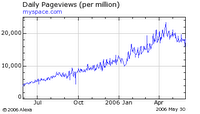
A week ago, Scott Karp at Publishing 2.0 wrote about declining pageviews on MySpace as recorded by Alexa. Declining or not, NY Times picked up the story today, so now what was a blog post last Sunday is a nationally broadcast piece of news. What will follow is more blogs linking to Scott's blog and NY Times, and then more mainstream publications writing on how everybody is talking about MySpace going the way of Friendster.
Anyway, it's not like MySpace will not fade out. GeoCities, anyone? Kids who are on the site now will grow up, go to college and move on, and the next generation will find a new hangout place that hasn't been used by "old farts". It's the same with toys -- each wave of kids has its own plastic heroes.
What's to be done? I'd say, don't go after the amorphous "teenager" demographic. Cater to a well-defined group that happens to be "teenagers" today, but will be "college students" tomorrow and "young professionals" the day after. Change your product in sync with the natural evolution of the audience's needs. If the product is a social networking site, then today it has the flavor of MySpace, tomorrow it's like FaceBook, and LinkedIn after that. And since the technologies behind such sites are fairly similar and can be easily recycled, you could replicate a separate MySpace for each new wave of users.





